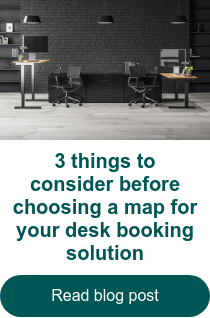Indoor maps are as indispensable as a cup of coffee on a Monday morning - you just cannot function without them.
Whether you provide a room and desk booking solution, event management platform, or facility management software an indoor map takes your product to the next level by adding spatial context to the data you provide.
Context boosts user experience
Imagine you work at a large corporate office and want to book a workspace for the day. You go into your booking solution to find an available desk. The list view tells you that Desk 407 is available, but where is Desk 407 located, and how do you know if any of your team members are sitting in the same area?
By adding an indoor map to the solution, you can see where desks are located on a map of the office and where your co-workers are sitting, taking the user experience to a whole new level.
Indoor maps significantly increase the user experience of any location-aware solution but they can also be rather expensive. This makes many companies opt for a cheaper version, but a cheaper map may be more expensive in the long run. We will get back to this later…
Static map vs. dynamic mapping platforms
Before we dig into why cheaper maps may end up costing you more money than an expensive one, let us take a look at the different map types available: static maps and dynamic maps.
Static maps
A static map is a CAD, PDF, or image that you integrate into your solution. It allows you to overlay static data and points of interest. However, similar to a printed map, once published, you cannot change the layout, the look, or the data.
Dynamic maps
A dynamic mapping platform consists of several layers, including digitized 2D or 3D floor plans, indoor and outdoor route networks, points of interest, and dynamic integrations.
Dynamic integrations are integrations with third-party systems, IoT devices, and sensors to show important data on the map in real time. This includes read/write integrations that enable users to book desks or rooms directly through the map.
Contrary to a static map, a dynamic map is easy to update through the included content management system.
But, let us cut to the chase: How does a seemingly budget-friendly static map potentially end up digging deeper into your pockets than a dynamic mapping platform?
Why a static map may become the most expensive solution
Reason #1: Scalability
Scalability is crucial if you want to grow your business.
Maybe you have 100 customers today, but how many will you have in two years? And what if your existing customers expand their businesses, adding more floors or buildings to their solution?
By choosing a scalable mapping platform for your solution you ensure that it can grow with your business and your customers’ businesses. A static map, on the other hand, may limit your growth opportunities in the long term, forcing you to buy a new map if you want to continue growing your business.
Reason #2: Updates
As mentioned above, the layout of static maps cannot be updated once the map is published. However, indoor environments are ever-changing.
Convention centers make thousands of floor plan changes while preparing for new events, and large corporate offices often make 50-100 floor plan adjustments daily to optimize their space utilization.
A dynamic mapping platform automatically updates your customers’ maps as they make floor plan changes in their integrated workspace management system and the changes are reflected on the map almost instantly. This means that they always have up-to-date maps and you never have to worry about the accuracy of your solution.
With a static map, you will have to create a new static map every time your customers make changes to their layout, making your solution expensive in the long run without adding the benefits of a dynamic mapping platform.
Reason #3: Upsell opportunities
As your business grows you might want to expand your solution as well. Depending on your industry, a dynamic mapping platform enables a range of upsell opportunities through add-ons of additional features.
As static maps do not integrate with third-party systems, IoT devices, and sensors, they do not offer the same opportunities and you may miss out on new revenue streams.
Whether you choose a static map or a dynamic mapping platform, integrating it into your solution requires both time and money. Hence, you do not want to find out, just a few years down the road, that the map you have integrated into your solution, no longer fulfills your requirement.
If you want to avoid the inconvenience and costs associated with acquiring a new map and undergoing another implementation process, it is crucial that you choose the right map from the beginning.
If you want to know more about what to consider before choosing a map for your solution, check out our blog post, 3 things to consider before choosing a map for your desk booking solution.

.png?width=220&name=Google_Premier_Partner%20(1).png)